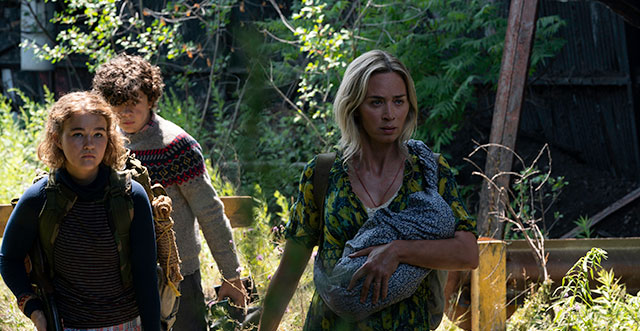
Actor/director John Krasinski turns 41 today, and with Halloween on the horizon, what better time to reflect on his breakout horror movie, A Quiet Place?
Released in 2018, A Quiet Place was a confident and accomplished scary movie debut for the star of The Office. He had made movies before, but nothing in this realm, and it was an engrossing, spooky delight. The film tells the story of an imperilled family carving out an existence in a world overrun by monsters. The twist is that the monsters hunt via sound, and the family must maintain a level of vigilant silence at all times.
Krasinski cast real-life wife Emily Blunt as his on-screen partner, and the film was a major critical and commercial success. Sequel A Quiet Place: Part II is scheduled (at the time of writing) to hit us in April 2021, and picks up the thread of the family's story, while also filling in the blanks as to when the monstrous beasts first arrived on Earth.
This also got us thinking: in addition to Krasinski, who are the first-time horror directors that made a splash in the genre? We've compiled a Halloween-friendly blog list for your entertainment. Scroll down to discover our choices.
1. George A. Romero – Night of the Living Dead (1968)
Nowadays, he's renowned as the grandfather of the zombie movie. But back in the 1960s, George A. Romero was a struggling commercials director, who could not imagine the impact he would make on the horror genre. His ultra-low-budget, black and white chiller Night of the Living Dead, made via his Image Ten Productions company, cast aside Gothic cliches, vampires, ghouls and the like to instead locate a plausible terror right in the heart of recognisable America.
His marauding zombies carry a distinctly political air: a reflection of societal apathy and a culture that's spun out of control. Admittedly, these analogies took great shape in the later Dawn of the Dead (1978), widely considered to be the best film in his 'Dead' trilogy'. Nevertheless, it all started here, with genuinely horrific moments alternating with racially charged overtones. (Actor Duane Jones broke new ground as an African-American lead in a horror film). The movie became one of the most successful indie releases of all time, grossing $30 million against its $114,000 budget.
2. Tobe Hooper – The Texas Chainsaw Massacre (1974)
Very often, it's illogical horror that's the scariest. Director Tobe Hooper carved out his place in cinema history with this hugely controversial, grungy shocker, which derived inspiration from real-life grave robber and necrophiliac Ed Gein. (He was also the inspiration for Norman Bates in Alfred Hitchcock's Psycho.) Shot for a pittance in and around Texas, assimilating a raw, home movie aesthetic, the film carries an air of verisimilitude that, to this day, is still genuinely unsettling to watch.
A distorted soundtrack only adds to the feeling of encroaching madness, as a group of naive teens fall foul of Leatherface (Gunnar Hansen) and his family. The film was banned by the BBFC until 1999 because the censors found it impossible to enforce individual edits – nothing they could do to the movie would shake off the air of apocalyptic menace. Ironically, the film contains minimal gore; everything occurs within the mind of the viewer, which only serves to make it more terrifying. Still, there's no denying the ghoulish presence of Leatherface himself, an immediate horror icon who has powered his way through numerous sequels and remakes.
3. Clive Barker – Hellraiser (1987)
Noted British author Clive Barker has frequently crossed boundaries in his tales of terror, including his 'Books of Blood' series. Barker then decided to adapt his own novel 'The Hellbound Heart' for the big screen as Hellraiser, a nightmarish onslaught of sadomasochistic imagery that plunges the audience into a world of madness.
The disturbing thing about Hellraiser is the elegance of its presentation. There are no cheap jump scares or shocks, the movie instead blurring the line between hellish horror and Gothic romance, as otherwordly visitors the Cenobites ("demons to some, angels to others") are summoned to reclaim the soul of the man who escaped them. Shot on a low budget, the movie showcases memorable creature effects, most notably Doug Bradley as the immediately intimidating Pinhead, who would become more prominent in the Hellraiser sequels. Composer Christopher Young's hypnotically eerie score lends further grandiosity and atmospheric weight to a pioneering British horror movie.
4. Kathryn Bigelow – Near Dark (1987)
In recent years, Kathryn Bigelow has become established as an objective chronicler of American life, working with screenwriter Mark Boal to explore American foreign policy (The Hurt Locker; Zero Dark Thirty) and domestic racial tensions (Detroit). But she made her name with the spellbinding Near Dark, a hybrid of vampire movie and dusty frontier Western.
Adrian Pasdar plays the innocent farmhand who is bitten by a beautiful vampire and condemned to forever walk in the moonlight. He falls in with a trio of cinema's creepiest vampires, played by Lance Henriksen, Jeanette Goldstein and Bill Paxton. The role of the psychotic Severin is a bloodcurdling thing of wonder, allowing the Paxton the rare opportunity to unleash himself in a villainous performance. Bigelow's staging, which contrasts low-rent dive bars with neon-streaked exteriors and icily windswept plains, combined with a thrumming Tangerine Dream score, makes this a truly entertaining bloodsucking bonanza.
5. Eduardo Sanchez and Daniel Myrick – The Blair Witch Project (1999)
With the onset of social media, it's become a lot more difficult to fool movie audiences. But in the relatively innocent bygone age of the late-1990s, filmmakers could tap into the power of the internet, at that point still a relatively newfangled thing, and twist it to their heart's content. No-one achieved his better than Eduardo Sanchez and Daniel Myrick, who spun their debut horror movie The Blair Witch Project into a global sensation. They did this via the simple suggestion that the movie was real, propogating online missing persons profiles of the characters, which then tied into the movie's hand-held, found-footage mystique.
It was a perfect of example of the right marketing at the right time, underscoring a film whose raw documentary aesthetic led viewers to question what they were watching. It recounts the trip taken by a group of teenage filmmakers, who allegedly disappeared in the woods near Burkitsville, Maryland while on the hunt for the dreaded Blair Witch. The directors didn't so much guide the actors as get them to travel from one place to another via GPS, messing with them en route by shaking their tents, playing sounds and leaving stick figures hanging in trees. The primal fear that radiates through the movie isn't so much simulated as deeply, properly felt. Little wonder that audiences came out the other side genuinely rattled at the possibility it was all real.
6. Jennifer Kent – The Babadook (2014)
An apparently haunted pop-up book becomes a figurative reflection of one family's breakdown in Jennifer Kent's masterful The Babadook. It was the debut feature film for the Australian director, and what an accomplished one it is. Leaving predictable scares at the door, it instead crafts a steadily mounting atmosphere of dread while also recognising that the best kind of horror is rooted in human emotion. After all, if we care about the characters, that means the terror experienced by the audience is more deeply felt.
Essie Davis is superb as Amelia, a troubled young mother left reeling by the sudden death of her husband. The event has also left her young son traumatised, and when a book arrives on their doorstep, appearing to portend the arrival of Mr. Babadook, things soon spiral out of control. The minimalist menace of Kent's direction, not least in said book with its malevolent illustrations, allows the audience to come to their own conclusions about what's going on. Is it all in Amelia's head, or is the Babadook real? No simple answers are forthcoming, but the questions linger in the mind long afterwards.
7. Robert Eggers – The Witch (2016)
The line between religious mania and supernatural threat becomes blurred in Robert Eggers' The Witch. Written and directed by Eggers, it was his feature film debut, and works effectively on two levels as an accurately observed period drama, and a quietly insidious horror film.
The movie takes place in the 17th century as a Puritan family are cast out of their enclave in the new world. They're banished to the edge of a forbidding woods where an evil witch may or may not lurk. However, is it the family's sense of piousness that's generating the threat? And are they, in fact, a greater danger to each other than any external ghouls and goblins? Chanelling the spirit of one of his great influences, The Shining, Eggers keeps us off-balance throughout. The cinematography approximates a washed-out look, akin to, but not quite, black and white, and Mark Korven's jittery score enhances the sense of threat. The actors, meanwhile, do a superb job reeling off Eggers' period-authentic dialogue (some of which is taken from real sources), notably breakout star Anya Taylor-Joy, who is next set to lead Mad Max spin-off movie Furiosa.
8. Jordan Peele – Get Out (2017)
Jordan Peele made cinema history with his striking horror debut Get Out. He became the first-ever African-American filmmaker to win the Oscar for Best Original Screenplay, validation for the film's deft blend of twisted wit and genuine terror. Peele comes out of the Key & Peele partnership, shared with Keegan-Michael Key. And that ability to make us laugh and shudder in equal measure gives Get Out a unique texture, mingling the mordantly funny overtones of The Stepford Wives with the instutional racism of 12 Years a Slave.
British actor Daniel Kaluuya is charismatic and confident as Chris, a black photographer whose visit to his white girlfriend's family goes horribly awry. Peele is not in it to make broad, obvious swipes at the spectre of racism. Instead, to paraphrase Goodfellas, he looks at how your racists come with smiles, under a veneer of liberal bonhomie. This gooses the movie with a prickly, drum-tight atmosphere, aided by further superb performances from Allison Williams, Bradley Whitford and Catherine Keener. Peele's literal depiction of white oppression, in the form of the hypnotically-induced other realm known as 'The Sunken Place', is one of many signs that we're in the hands of a truly brilliant horror filmmaker.
9. Rose Glass – Saint Maud (2020)
A palliative nurse believes she's destined for redemption in this striking horror feature debut from Rose Glass. As Rose discussed in our Cineworld interview (check it out here), she has an affinity with the offbeat and surreal, and she channels those passions into this story of faith-based psychosis. Morfydd Clark is startlingly good as Maud, a carer with a murky past who believes she's destined to save soul of apparently sinful patient Eve (Jennifer Ehle, all insinuating smiles and innunendos).
The film is cloaked in a shadowy atmosphere that literalises the closed-off emotional state of its central character. As the film progress, the imagery appears to become more explicit, but throughout we're being forced to question the nature of what we're seeing. So effectively does the movie plunge us into Maud's world that we swiftly lose sight of the boundary between actual and imagined, good and evil. It's a powerful first offering from Rose Glass and promises great things to come further down the line.
10. Natalie Erika James – Relic (2020)
As with The Babadook, creepy chiller Relic derives its most potent terror from the interaction between believable characters. Three generations of women collide in this accomplished horror feature from Natalie Erika James, who graduates from music videos and short films to full-blown movies with ease. The film walks a tricky line, utilising the supernatural as a metaphor for the onset of dementia. But far from trivialising a devastating real-life condition, James fuses the relatable conceit with the audience-pleasing notions of mainstream horror to satisfying effect.
Emily Mortimer and Bella Heathcote play a mother and daughter who are caring for the former's own mother (played by Aussie stage veteran Robyn Nevin). However, the atmosphere of the house they're occupying begins to moulder and fester, signifying a decline that has potent emotional ramifications for all of them. The chemistry between the three leads, plus a refusal to play the material for cheap scares, ensures this is a narratively robust chiller that will induce gasps and tears in equal measure.
What's your favourite film from our list? Or have we missed out your favourite altogether? Let us know @Cineworld.
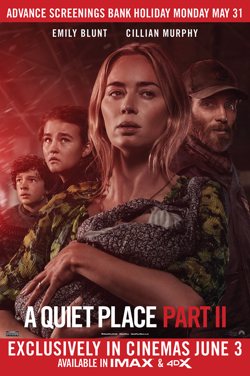
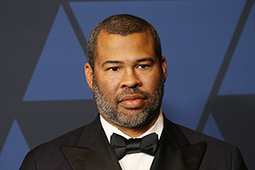
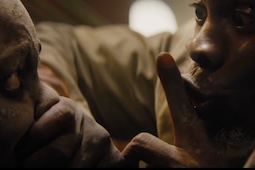
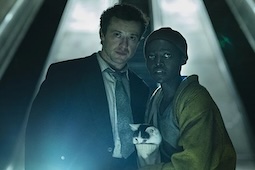
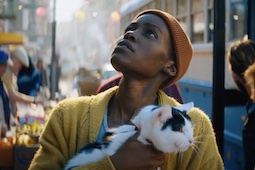
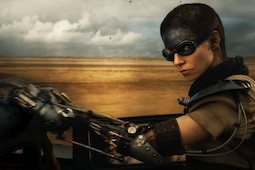

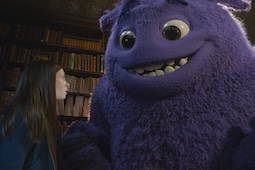




.jpg)
.png)






